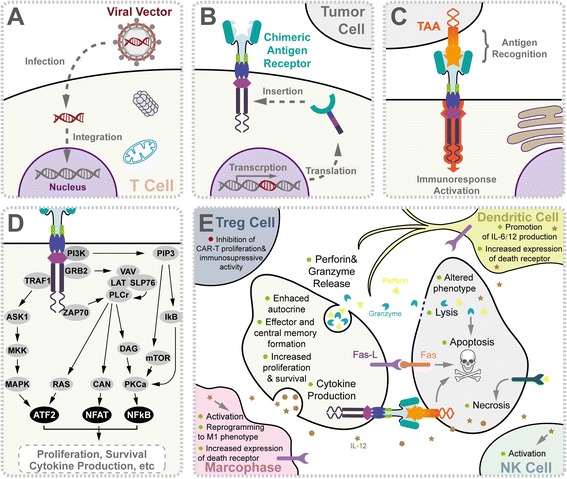Fig. 1.

Molecular mechanism of chimeric antigen receptor T cell-mediated antitumor activity. a The chimeric T cell receptor coding sequence is delivered by viral vector. After entering into T cells (beige), virus was uncoated and transgene was preferably integrated at genome transcriptional start sites using specific vector designs, such as MLV retrovirus and piggyBac transposon. b CAR transgenes were endogenously transcript by host machinery, translated, and later inserted onto the T cell surface. c Association of CARs to TAA (orange) on tumor cell surface activates T cell for immunological response, for example, signaling network of CAR-T composed of CD8-CD28-CD137-CD3ζ domains was shown in (d). CAR-T-mediated immune response was reported to be amplified by ZAP70, TRAF1, PI3K, and GRB2 as well as other uncharacterized factors, giving rise to upregulation of signaling intermediates and subsequent pro-death gene transcriptions. e Upon CAR activation, T cells secreted cytokines (brown), perforins (bright yellow), and granzymes (blue) as well as activated death receptors, which triggered downstream targets. These subcellular events directly or subsequently contribute to specific death of tumor cells, including perforin and granzyme release, cytokine production, direct lysis, apoptosis, necrosis, reprogrammed phenotype, and immuno-memory formation in T cells, tumor cells (gray), macrophages (pink) (via IL-6, IL-10, IL-12, MCP-1, IP-10, TNF-α, MIP-1α, MIP-1β, IFN-γ), NK cells (cyan) (via IL-12, TNF-α, IFN-γ), Treg cells (navy) (via IL-2, IL-4, IL-7, IL-12, IL-15, IFN-β, IFN-γ, TSLP), and dendritic cells (yellow) (via IL-6, IL-10, IL-12, TNF-α, MIP-1α, MIP-1β, IFN-γ). Abbreviation: NK cells natural killer cells, TAA tumor-associated antigen, Treg cells regulatory T cells
